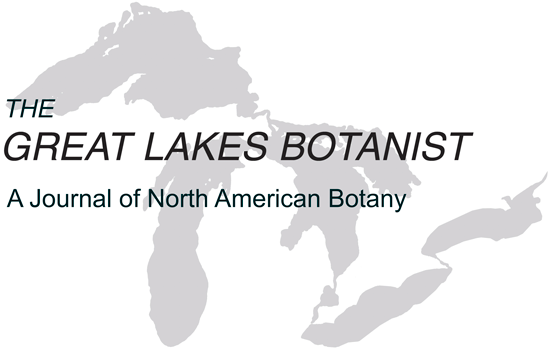ï~~2008
THE MICHIGAN BOTANIST
21
Desmodium glutinosumn, Galium pilosumn, Elymus hy strix, Sanguinaria canadensis, Scrophularia marila dica, Solidago flexicaulis, Trillium grandiflorum) and
of prairies and savannas (Aster oolentangiensis, Comandra umbellata, Coreopsis tripteris, Elymus catnadensis, Galium boreale, Hypoxis hirsuta, Lactu.ca
canadensis, Monarda fistulosa, Phlox pilosa, Rosa carolina, Veronicastrum virginicum). Some of Daniel's oak openings plants grow in both shaded and sunny
locations (e.g., Geranium nmaculatum, Hepatica americana, Podophyllun peltatun, Thalictrumin dioicum).
In Ohio's oak openings region Anderson (1971) also documented the presence of herbs that grew in both woods and prairies. Where Anderson (1971)
worked, the woods were burned, the woody understory was kept in check, light
levels were relatively high inside the woods, and consequently several species
grew in both prairies and woods (Baptisia tinctoria, Coreopsis tripteris, Lupinus
perennis, Monarda fistulosa, Sisyrinchium albidum). Winn and Kapp (1986) observed similar patterns of plant distribution in dry sand prairie and adjacent oak
woodlands of west-central Michigan.
Curtis (1959) also documented the differential response of prairie species
across a light gradient; some species (e.g., Amphicarpa bracteata, Aster laevis,
Cornus racemosa, Corylus americana, Helianthus stru.mosus) were most frequent under the oak crowns where mid-day light levels were below 1,000 footcandles; some (e.g., Amorpha canescens, Andropogon gerardii, Helianthus laetiflorus, Schizachyrium scoparium, Stipa spartea) most frequent between oak
crowns or where a tree had died (10,000 foot-candles), and some (e.g., Coreopsis panliata, Euphorbia corollata, Monarda fistulosa, Solidago ulmifolia) most
frequent in intermediate shade conditions.
Until the cessation of annual burning in the mid-1800s, both shade-tolerant
and shade-intolerant plants of Michigan's oak openings grew within meters of
each other under varying light conditions caused by different tree densities in the
historical oak openings. After burning ceased, light grazing enabled the shadeintolerant plants to persist in woodlands, but when livestock were removed forest succession resumed. As forest succession converted the majority of the oak
openings to forest, shade-intolerant plants tended to coalesce into what today are
called prairies. There they survived as long as tree cutting, plowing, scraping,
burning, or grazing continued at less than destructive intensities.
Soils. While soils of oak openings are generally dry-mesic, the soils are not like
those of dry-mesic prairies elsewhere in the tallgrass prairie region. Wisconsin's
dry-mesic prairies are on udic mollisols, true prairie soils (Curtis 1959), while
Michigan's oak openings occur on udic alfisols, or forest soils. Alfisols have less
organic matter in the A horizon, have accumulated irons and other metals in the
B horizon due to leaching, and have lower pH than mollisols of typical drymesic prairie. These soil characteristics are indicative of long-term forest occupancy, not treeless prairie.
Community Characteristics. Oak openings was the least homogeneous plant
community studied, had a single indicator, and shared the most species with
other communities. The lack of homogeneity may be related to the large geo
0


